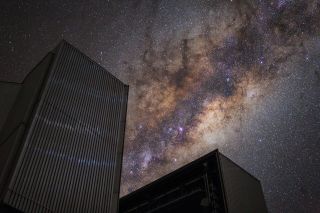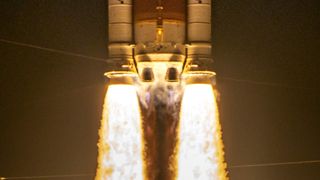Space pictures! See our space image of the day
Ride into the danger zone.
Space can be a wondrous place, and we've got the pictures to prove it! Take a look at our favorite space pictures here, and if you're wondering what happened to today in space history don't miss our On This Day in Space video show here!
X-59 hits the afterburner

Monday, December 23, 2024: Engineers with NASA and Lockheed Martin recently completed the first full afterburner test on the revolutionary new X-59 'quiet' supersonic jet. The X-59 was designed from the ground-up to break the sound barrier without generating the characteristic thunderous sonic booms that supersonic flight is known for. The aircraft fired its engine for the first time in November 2024, and engineers are working towards the jet's first flight which will see the X-59 fly over select populated areas to see how people on the ground perceive and respond to the quieter "thumps" it produces when breaking the sound barrier.
Read more: NASA will fly F-15s through supersonic shock waves behind its experimental X-59 jet
Christmas Tree nebula gets some fresh ornaments

Friday, December 20, 2024: We've all looked for shapes in Earth's clouds. But what about shapes in space clouds? If you glance at NGC 2264, you'll see very quickly why this cluster of stars is nicknamed the "Christmas Tree Cluster." This cluster has become the recent subject of astrophotographer Michael Clow, who imaged it from Arizona in November. His optical data have been combined with X-ray data from NASA's Chandra X-Ray Observatory to create this beautiful Christmas tree-like image of NGC 2264, showcasing not only the stars themselves, but also the gas clouds between them. — Stefanie Waldek
Read more: NASA space telescopes give Christmas Tree Cluster a festive makeover (photos)
It's Krytpo!

Thursday, December 19, 2024: Did you see it?? The new 'Superman' trailer?? It's Krypto, y'all! The DOG! Dragging Superman through the snow to save him! Who's a good boy?? It's Krypto! Read more: Everything we know about James Gunn's 'Superman'
Suni beaming with an Astrobee

Wednesday, December 18, 2024: What could be better than NASA astronaut Suni Williams floating aboard the International Space Station with Bumble, the blue, bunny-eared Astrobee. Bumble is one of three cube-shaped robo-helpers developed by NASA to assist astronauts aboard the space station. The free-flying robots perform various tasks, including documenting experiments or taking inventory, and are able to navigate, dock and recharge themselves autonomously within the orbiting lab.
Get the Space.com Newsletter
Breaking space news, the latest updates on rocket launches, skywatching events and more!
NASA astronaut Suni Williams, who is currently serving as Expedition 72 Commander on the ISS, smiles for a photo with the robotic flyer in the Kibo laboratory module in a new image shared by NASA. Williams can be seen imitating the robot's curved arms, which are being tested to wrap around objects for satellite maintenance and space debris management.
Read more: NASA astronaut Suni Williams poses with adorable tentacle-armed Astrobee robot on ISS
Feel the burn this season

Tuesday, December 17, 2024: If you're not yet in the holiday spirit, NASA is here to bring you the rest of the way. The space agency created a virtual fireplace lit by the engines of its huge Space Launch System (SLS) rocket, which sent the uncrewed Artemis 1 mission to the moon in November 2022.
In this photo, the fireplace can be seen displayed on NASA's mission countdown clock at the Kennedy Space Center, in Florida, with one of the world's largest buildings, the Vehicle Assembly Building (VAB), standing tall in the background.
Read more: Warm up this holiday season with NASA's new SLS rocket engine fireplace (video)
Observe the Geminids!

Monday, December 16, 2024: In Hawaii, astronomers with Japan's Subaru Telescope atop Maunakea in captured a stunning image of more than 100 Geminid meteors streaking across star trails in a long-exposure view from the observatory's camera.
"The Subaru-Asahi Star Camera at the Subaru Telescope Facility, Maunakea, Hawai‘i, captured over 150 meteors in one hour from 1:10 to 2:10 a.m. on December 13, 2024 (HST) despite the bright moonlight, as shown in this summary picture," officials with the observatory said on X, formerly Twitter, while sharing the photo. "Most meteors belong to Geminids."
Read more: See the best Geminid meteor shower 2024 photos from around the world
A satellite's circle of aurora

Thursday, December 12, 2024: As the year approaches its end, everyone is rounding up their best images of 2024. The National Oceanic and Atmospheric Administration (NOAA) is joining in, asking social media users to help choose their "most compelling" satellite image.
Pictured here, a Day-Night Band image from NOAA's JPSS Program satellites, showing Earth's northern hemisphere from above, crowned in a ring of aurora borealis.
Saturn's elusive dark ring spokes

Wednesday, December 11, 2024: NASA is celebrating ten years of the Hubble Space Telescope's Outer Planter Atmospheres Legacy (OPAL) program, which helps track weather and seasonal changes in the atmospheres of our solar system's gas giants. One of OPAL's observations has helped astronomers Saturn's elusive dark ring spokes. First discovered by NASA's Voyager mission in the 1980s, these dark rings only last for two or three rotations around Saturn. Thanks to Hubble, astronomers now know the rings to be a seasonally-driven phenomenon.
Through a Dragon's eye

Tuesday, December 10, 2024: Through the window of a SpaceX Crew Dragon spacecraft, the small structure of the International Space Station (ISS) can be seen flying above the clouds below. This photo was taken by a Crew-8 astronaut as their Dragon spacecraft undocked and departed the ISS above the Pacific Ocean, off the coast of Chile.
Moon photobombs atmospheric probe test

Monday, December 9, 2024: NASA photographer Steve Freeman caught a lucky shot of the moon photobombing a drone carrying a model of an atmospheric probe being developed by NASA's Armstrong Flight Research Center in Edwards, California. The quad rotor carried the probe to a test altitude before releasing it over Rogers Dry Lake, a flight test area next to the NASA center.
That's no moon...

Wednesday, December 4, 2024: Well, yeah, it's definitely not a moon, but it does sort of looks like a half-assembled Death Star in "Star Wars: Return of the Jedi", which is also not a moon. This is, in fact, the European Southern Observatory's (ESO's) Extremely Large Telescope (ELT) under construction. The skeleton of one of ESO's flagship cosmic imager for the coming decades can be seen here coming together piece by piece in the mountains of Chile’s Atacama Desert. Once complete, ELT's enormous primary mirror will measure 128 feet (39 meters) across.
The cupola the keeps on giving

Tuesday, December 4, 2024: Few things beat the view of a good sunset, even when that view happens on repeat 16 times a day. Thanks to the altitude and inclination of the International Space Station's orbit, that's exactly how many sunsets astronauts living aboard the orbital lab get to experience. In this photo, NASA astronaut Tracy Dyson peers out the station's cupola module as the sun sinks behind the shadowy face of Earth's night side. 262 miles below, the blue tint of the South Atlantic Ocean paints the faded arch of Earth's horizon with a soft glow, lit from the falling sun like Dyson's face as she stares at our home planet.
A stretch of Milky Way

Monday, December 2, 2024: Between these two blocky buildings, the arm of our Milky Way stretches into the night sky. This photo was taken from European Southern Observatory's (ESO's) Very Large Telescope (VLT), high in the Chilean mountains. Pictured, the VLT's fourth Unit Telescope, stands like two pillars guiding the galaxy's arm.
November >
Can't find the date you're looking for? It may have been a weekend or holiday, when we don't normally update our Image of the Day.
Click 'NEXT PAGE' below for November >
Image of the Day Archives
Image of the Day 2024 Archive

Image of the Day 2023 Archive

Image of the Day 2022 Archive

Image of the Day 2021 Archive

Image of the Day 2020 Archive

Image of the Day 2019 Archive

Join our Space Forums to keep talking space on the latest missions, night sky and more! And if you have a news tip, correction or comment, let us know at: community@space.com.

Space.com is the premier source of space exploration, innovation and astronomy news, chronicling (and celebrating) humanity's ongoing expansion across the final frontier. Originally founded in 1999, Space.com is, and always has been, the passion of writers and editors who are space fans and also trained journalists. Our current news team consists of Editor-in-Chief Tariq Malik; Editor Hanneke Weitering, Senior Space Writer Mike Wall; Senior Writer Meghan Bartels; Senior Writer Chelsea Gohd, Senior Writer Tereza Pultarova and Staff Writer Alexander Cox, focusing on e-commerce. Senior Producer Steve Spaleta oversees our space videos, with Diana Whitcroft as our Social Media Editor.
-
rod ReplyThe Exoplanets Channel said:The images are truly breath-taking.
The Exoplanets Channel, what star and reddish exoplanet is shown in your picture, looks like about 8" angular separation? I use this site as my canonical reference to exoplanets, The Extrasolar Planets Encyclopaedia Currently 4150 exoplanets are listed. -
swiggly ReplyThe Exoplanets Channel said:The images are truly breath-taking.
My Comet Image:
Neowise -
rod Reply
This is a very good image here. In enjoyed some recent views of NEOWISE using my 90-mm telescope at 40x early, shortly after 0415 EDT. Bifurcated tail obvious too.swiggly said:My Comet Image:
Neowise -
Helio The IOD image for yesterday of the Veil nebula is stunning! The graphics are such that it's almost as if it has an oil film on top. It has both 3D and texture feel to it.Reply -
Astro.Letizia I hope they start posting these daily again! I always start my day off with the newest image but it's been a couple of months now :(Reply